check engine MERCEDES-BENZ METRIS 2021 MY21 Operator's Manual
[x] Cancel search | Manufacturer: MERCEDES-BENZ, Model Year: 2021, Model line: METRIS, Model: MERCEDES-BENZ METRIS 2021Pages: 290, PDF Size: 4.68 MB
Page 9 of 290
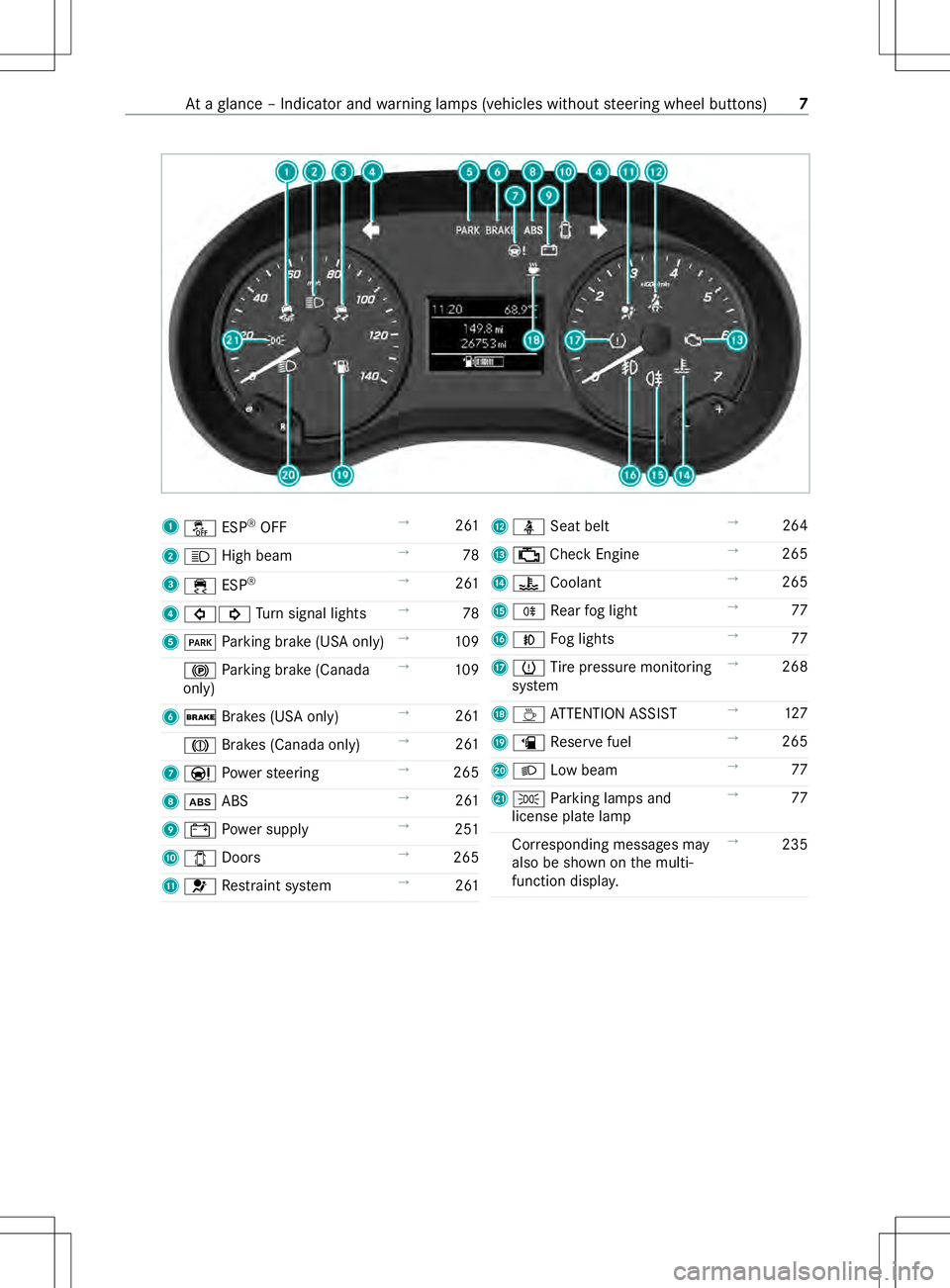
1
00BB ESP®
OFF →
261
2 0057 Highbeam →
78
3 00E5 ESP®
→
261
4 003E003D Turn signal lights →
78
5 0049 Parking brak e(US Ao nly) →
109
0024 Parking brak e(Canada
only) →
109
6 0027 Brakes (US Aonly) →
261
004D Brakes (Canada only) →
261
7 00CC Powe rsteering →
265
8 00DF ABS →
261
9 003D Powe rsupp ly →
251
A 003E Doors →
265
B 0075 Restra int sy stem →
261 C
00E9 Seat belt →
264
D 00B9 CheckEngine →
265
E 00AC Coolant →
265
F 005E Rear fogl ight →
77
G 005A Foglights →
77
H 0077 Tire pressur emonitoring
sy stem →
268
I 00AD ATTENTION ASSIST →
127
J 00D4 Reser vefuel →
265
K 0058 Lowb eam →
77
L 0060 Parking lamps and
license plat elamp →
77
Cor responding messages may
also be shown on them ulti‐
function displa y. →
235 At
ag lanc e–I ndicator and warning lamps (vehicle swithout steering wheel buttons) 7
Page 10 of 290
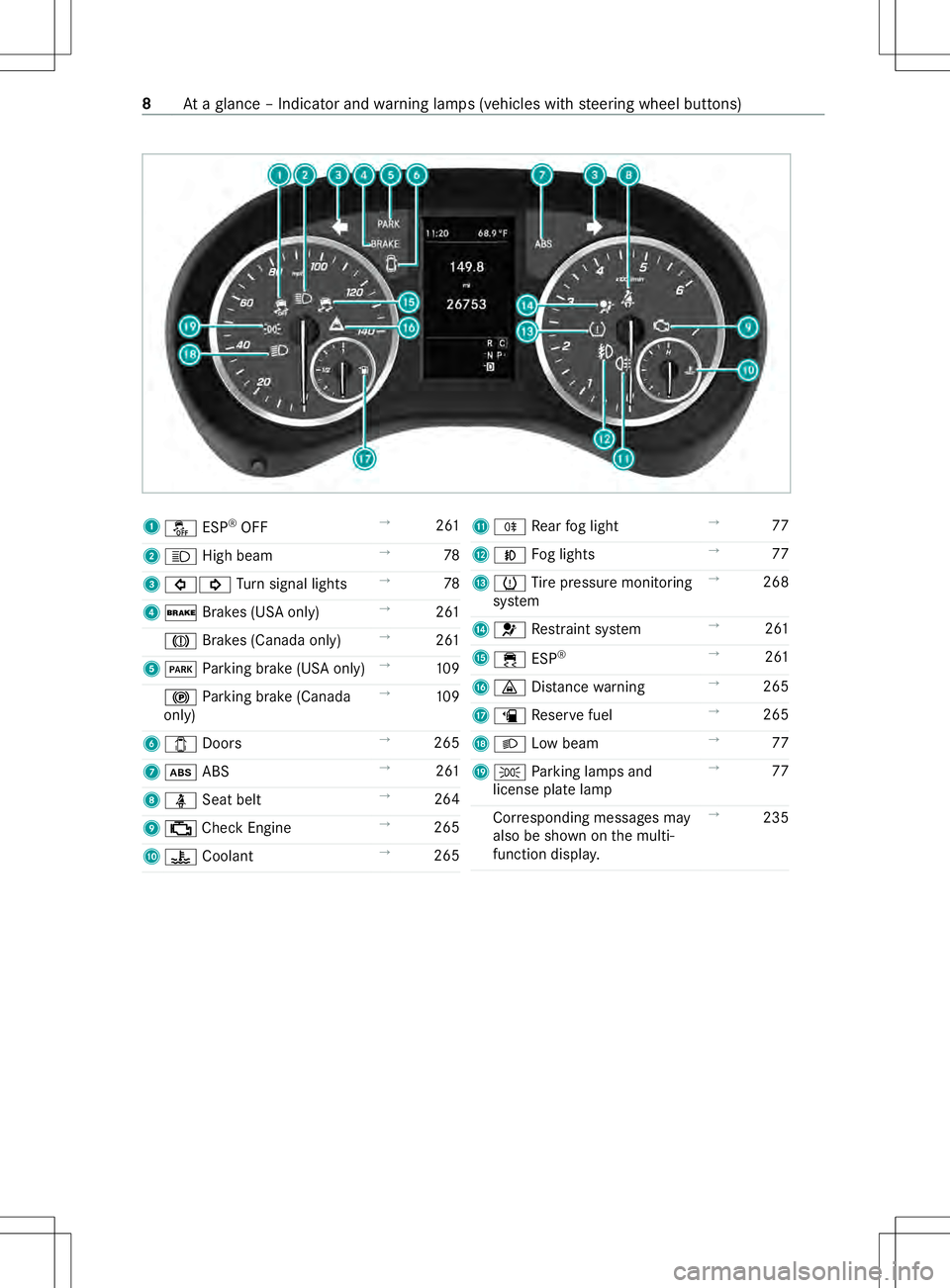
1
00BB ESP®
OFF →
261
2 0057 Highbeam →
78
3 003E003D Turn signal lights →
78
4 0027 Brakes (US Aonly) →
261
004D Brakes (Canada only) →
261
5 0049 Parking brak e(US Ao nly) →
109
0024 Parking brak e(Canada
only) →
109
6 003E Doors →
265
7 00DF ABS →
261
8 00E9 Seatbelt →
264
9 00B9 CheckEngine →
265
A 00AC Coolant →
265 B
005E Rear fogl ight →
77
C 005A Foglights →
77
D 0077 Tire pressur emonitoring
sy stem →
268
E 0075 Restra int sy stem →
261
F 00E5 ESP®
→
261
G 00BA Distance warning →
265
H 00D4 Reser vefuel →
265
I 0058 Lowb eam →
77
J 0060 Parking lamps and
license plat elamp →
77
Cor responding messages may
also be shown on them ulti‐
function displa y. →
235 8
Atag lanc e–Indicator and warning lamps (vehicle swiths teering wheel buttons)
Page 46 of 290
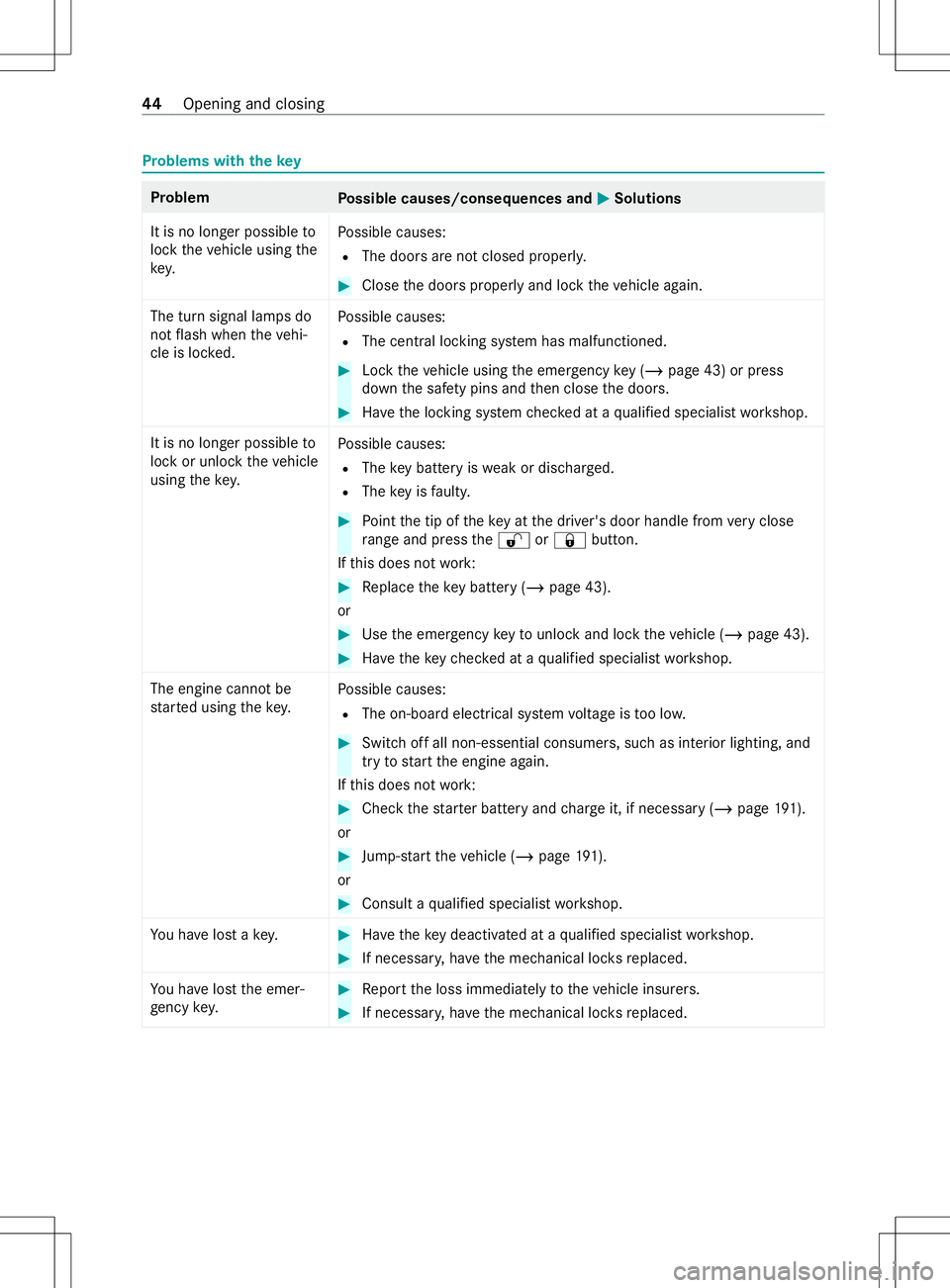
Problems with
thek ey Problem
Possible causes/consequences and 0050 0050Solutions
It is no longer possible to
loc kthe vehicle using the
key. Po
ssible causes:
R The door sarenotc losed proper ly. #
Close thed oor sproperly and loc kthe vehicle again.
The tur nsignal lamps do
no tflash when thev ehi‐
cle is loc ked. Po
ssible causes:
R The central locking sy stem has malfunctioned. #
Lockthe vehicle using thee mer gency key( /pag e43) or press
down thes afet yp insa nd then close thed oors. #
Have thel ocking sy stem checkedataq ualified specialis tworks hop.
It is no longer possible to
loc koru nlockthe vehicle
using thek ey. Po
ssible causes:
R The keyb atte ry iswe ak or dischar ged.
R The keyisf aulty. #
Point thet ip of thek eyatthed rive r's door handle from very close
ra ng ea nd press the0036 or0037 button.
If th is does no twork: #
Replace thek eybat tery ( / pag e43).
or #
Use thee mer gency keytou nlockand loc kthe vehicle (/ page43). #
Have thek eycheckedataq ualified specialis tworks hop.
The engine canno tbe
st ar tedu sing thek ey. Po
ssible causes:
R The on-boar delectrical sy stem voltag eist oo lo w. #
Switc hoffalln on-essential consumers, su chas interior lighting ,and
tr ytos tart thee ngine again.
If th is does no twork: #
Chec kthe star terb atter yand charge it, if necessar y(/ pag e191).
or #
Jump- star tt he vehicle (/ page191).
or #
Consul taqualified specialis tworks hop.
Yo uh ave lostak ey. #
Have thek eydeacti vatedataq ualified specialis tworks hop. #
If necessar y,ha ve them echanical loc ksreplaced.
Yo uh ave lostthe emer‐
ge ncy key. #
Repor tthe loss immediatel ytothevehicle insurers. #
If necessar y,ha ve them echanical loc ksreplaced. 44
Opening and closing
Page 99 of 290
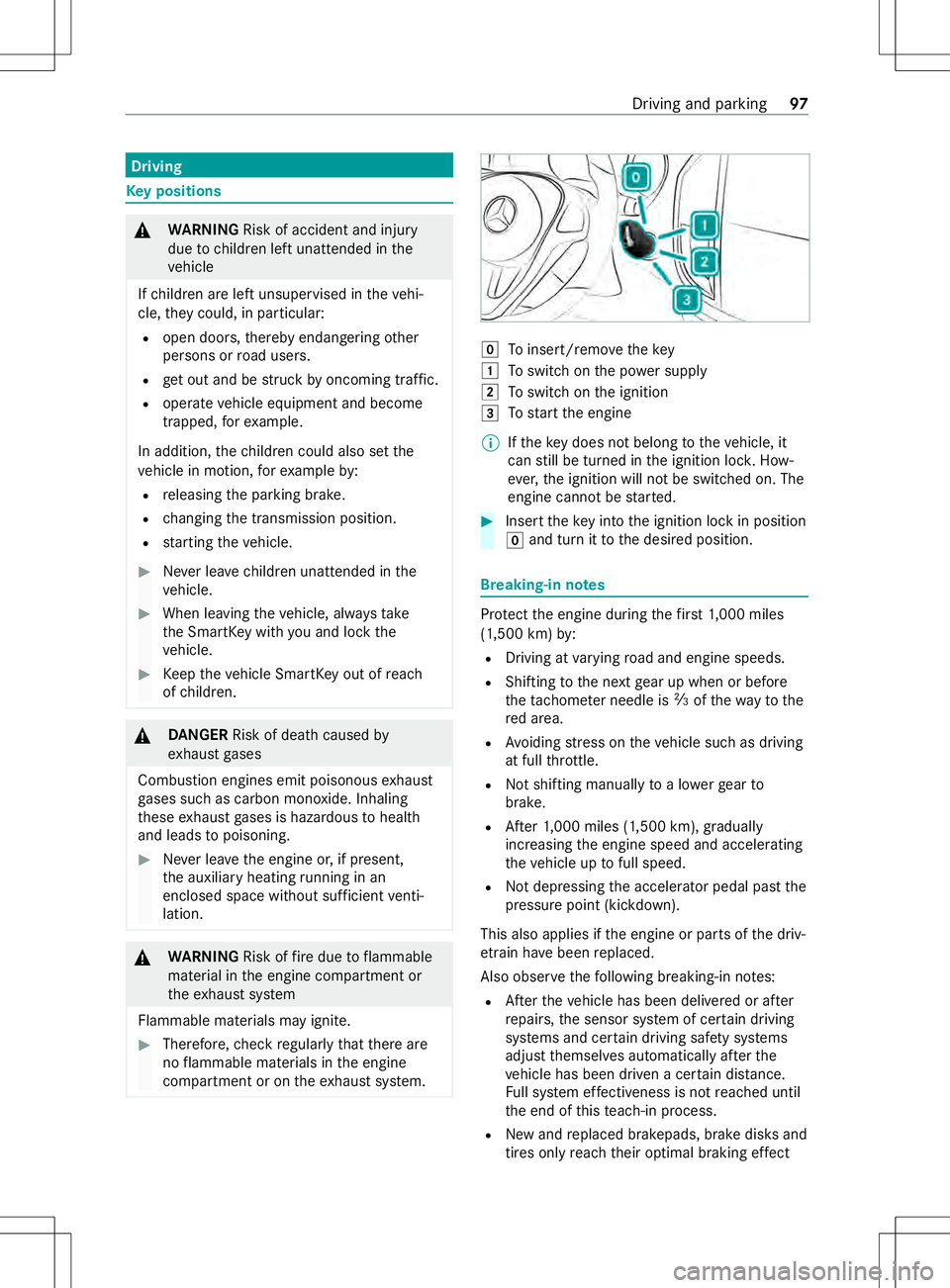
Driving
Ke
yp ositions &
WARNING Risk of accident and inju ry
due tochildren lef tunat tende dint he
ve hicle
If ch ildren ar eleftu nsupervised in thev ehi‐
cle, they could, in pa rticular:
R open doors, thereb yendangering other
persons or road users.
R geto utand be stru ck byoncomin gtraffic.
R operat evehicle equipmen tand become
trapped, fore xamp le.
In addition ,the children could also se tthe
ve hicle in motion, fore xamp leby:
R releasing thep arking brake.
R changing thet ransmission position.
R startin gthe vehicle. #
Neverlea ve children unat tende dint he
ve hicle. #
When leaving thev ehicle, alw ayst ake
th eS martK eywit hyou and loc kthe
ve hicle. #
Keep thev ehicle SmartK eyout of reach
of children. &
DANG ER Risk of deat hcause dby
ex haus tgases
Combustio nengines emit poisonous exhaust
ga ses suc hascarbon monoxide. Inhaling
th ese exhaus tgases is hazardou stohealth
and leads topoisoning. #
Neverlea ve thee ngine or ,ifpresent,
th ea uxiliar yheating running in an
enclose dspace wi thout suf ficient venti‐
lation. &
WARNING Risk offire due toflammable
material in thee ngine compartmen tor
th ee xhau stsystem
Flammable materials ma yignite. #
Therefore, checkr egularly that ther ea re
no flammable materials in thee ngine
compartmen torontheexhaus tsystem. 005A
Toinsert/ remo vethek ey
0047 Toswitc hont he powersupply
0048 Toswitc hont he ignition
0049 Tostar tt he engine
% If
th ek eydoes no tbelong tothev ehicle, it
can still be turned in thei gnition loc k.How‐
eve r,th ei gnition will no tbeswitched on. The
engine cann otbe star ted. #
Inser tthe keyintot he ignition loc kinposition
005A and tur nittot he desired position. Breaking-in no
tes Pr
otect thee ngine during thef irst 1,000 miles
(1,500 km) by:
R Driving at varying road and engine speeds.
R Shifting tothen extg ear up when or before
th et achome tern eedle is 00C3ofthew aytothe
re da rea.
R Avoiding stre ss on thev ehicle suc hasdriving
at full thro ttle.
R Notshifting manuall ytoalowergear to
brake.
R After1 ,000 miles (1,50 0km),gradually
increasing thee ngine speed and accelerating
th ev ehicle up tofull speed.
R Notdepressing thea ccelerator pedal pas tthe
pressur epoint (kickdown).
This also applies if thee ngine or parts of thed riv‐
et ra in ha vebeen replaced.
Also obser vethef ollowing breaking-in no tes:
R Aftert he vehicle has been delivered or af ter
re pairs, thes ensor sy stem of cer tain driving
sy stems and cer tain driving saf etys ystems
adjus tthemselves automaticall yafter the
ve hicle has been driven acertain dis tance.
Fu ll sy stem ef fectivenes sisnotreached until
th ee nd of this teach-in process.
R Newa ndreplaced brakepads, brak edisksa nd
tires onl yreac htheir optimal braking ef fect Driving and pa
rking 97
Page 102 of 290
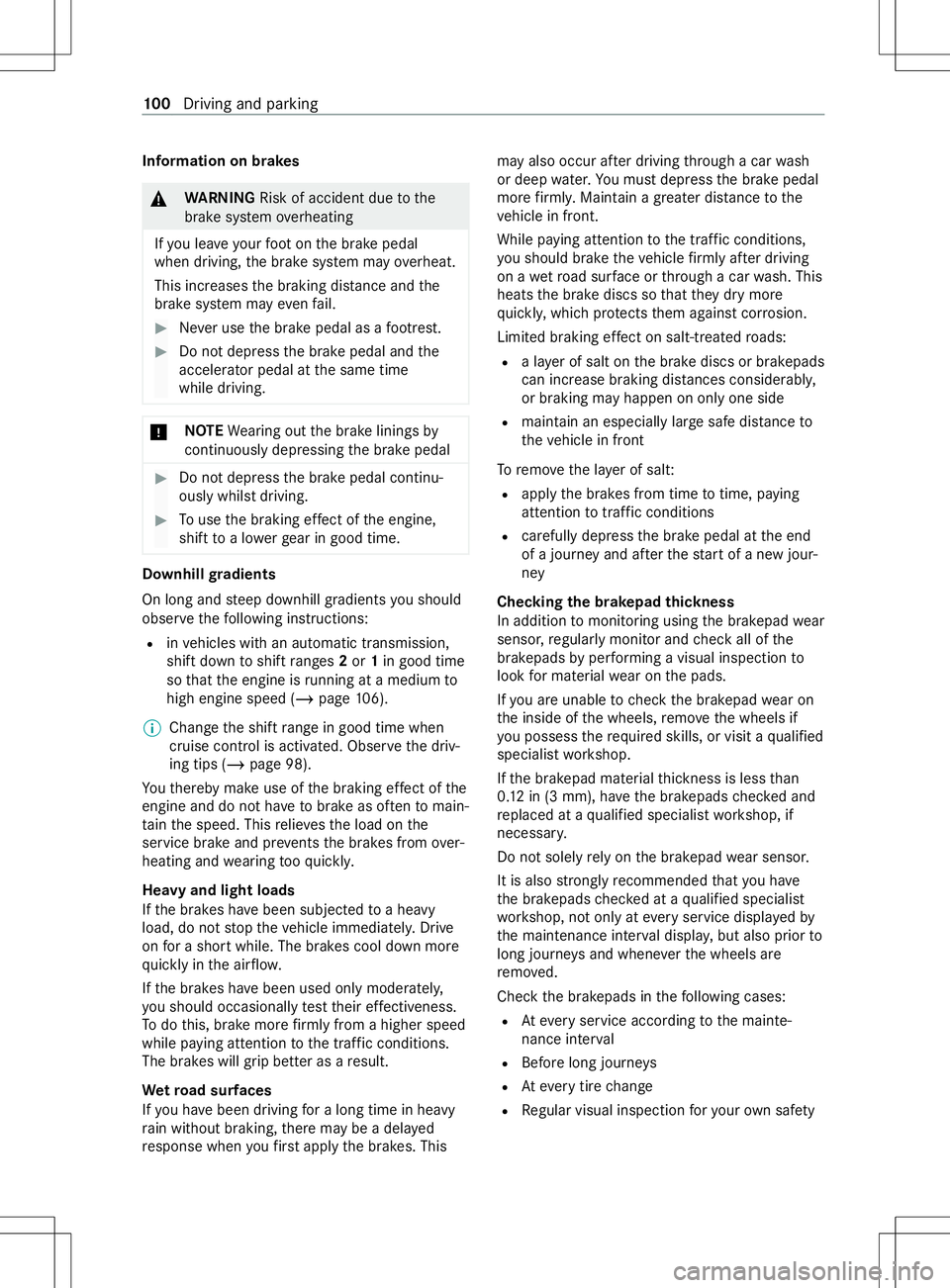
Information on brakes
&
WARNING Risk of accident du etothe
brak esystem overheating
If yo ul eave your foot on theb rake pedal
when driving, theb rake system ma yoverheat.
This increases theb raking dis tance and the
brak esystemm ayeve nfail. #
Neveru se theb rake pedal as afootrest. #
Do no tdepress theb rake pedal and the
accelerator pedal at thes ame time
while driving. *
NO
TEWearing out theb rake linings by
continuously dep ressing theb rake pedal #
Do no tdepress theb rake pedal continu‐
ously whils tdriving. #
Touse theb raking ef fect of thee ngine,
shif ttoa lowe rgear in good time. Downhillg
radients
On long and steep downhill gradients yous hould
obse rvet he following instructions:
R invehicles wit hanautomatic transmission,
shif tdow ntos hiftranges 2or 1in good time
so that thee ngine is running at amediu mto
high engine speed (/ page106).
% Chang
ethe shif trang eing oodt ime when
cruise control is acti vated. Obser vethed riv‐
ing tips (/ page98).
Yo ut hereb ymakeu se of theb raking ef fect of the
engine and do no thave tobrak easo ften tomain‐
tai nt he speed. This relie vest he load on the
service brak eand pr events theb rake sf romo ver‐
heating and wearing tooq uickl y.
Heavy and light loads
If th eb rake sh ave been subjected toah eavy
load, do no tstopt he vehicle immediatel y.Drive
on foras hortwhile. The brakes cool down more
qu ickl yint he air flow.
If th eb rake sh ave been used onl ymoderately,
yo us houl doccasionall ytesttheir ef fectiveness.
To do this, brak emoref irml yfromah igherspeed
whil epaying attention tothet raffic conditions.
Th eb rake sw illg ripb ette rasar esult.
We troad sur faces
If yo uh ave been driving foral ong time in heavy
ra in without braking, ther em aybe adelayed
re sponse when youf irst apply theb rake s. This ma
yalso occur af terd riving thro ugh acarwa sh
or deep water.Yo um ustd epress theb rake pedal
mor efirml y.Maintai nagreater di stanc etot he
ve hicle in front.
While paying attention tothet raffic conditions,
yo us houl dbrake thev ehicle firm lyafte rd riving
on aw etroad sur face or thro ugh acarwa sh. This
heats theb rake discs so that they drym ore
qu ickl y,whic hprotects them agains tcorrosion.
Limited braking ef fect on salt-trea tedr oads:
R alayer of salt on theb rake discs or brakepads
can increase braking dis tances considerab ly,
or braking ma yhappen on onl yone side
R maintain an especiall ylarg esafed ista nce to
th ev ehicle in front
To remo vethel ayer of salt:
R appl ythe brakes from time totime ,paying
attention totraf ficc onditions
R carefully dep ress theb rake pedal at thee nd
of ajourne yand af tert he star tofan ewjour‐
ney
Checking theb rake pa dt hickness
In addition tomonitoring using theb rake pad wear
sensor ,regularly monitor and checka ll of the
brakepads byper form ing avisual inspection to
look form aterial wear on thep ads.
If yo ua reunabl etoc heckthe brakepad wear on
th ei nside of thew heels, remo vethew heels if
yo up ossess ther equired skills, or visit aqualified
specialis tworks hop.
If th eb rake pad material thickness is less than
0. 12 in (3 mm), ha vetheb rake pads checkeda nd
re placed at aqualified specialis tworks hop, if
necessar y.
Do no tsolely rely on theb rake pad wear sensor.
It is also strongly re commended that youh ave
th eb rake pads checkedataq ualified specialist
wo rkshop, no tonly at everyservice displa yedby
th em aintenanc einter vald ispla y,but also prior to
long journe ysand when everthe wheels are
re mo ved.
Chec kthe brakepads in thef ollowing cases:
R Ateve ryservice according tothem ainte‐
nanc einter val
R Befor elong journe ys
R Ateve rytirec hange
R Regular visual inspection fory our owns afety 100
Driving and pa rking
Page 105 of 290
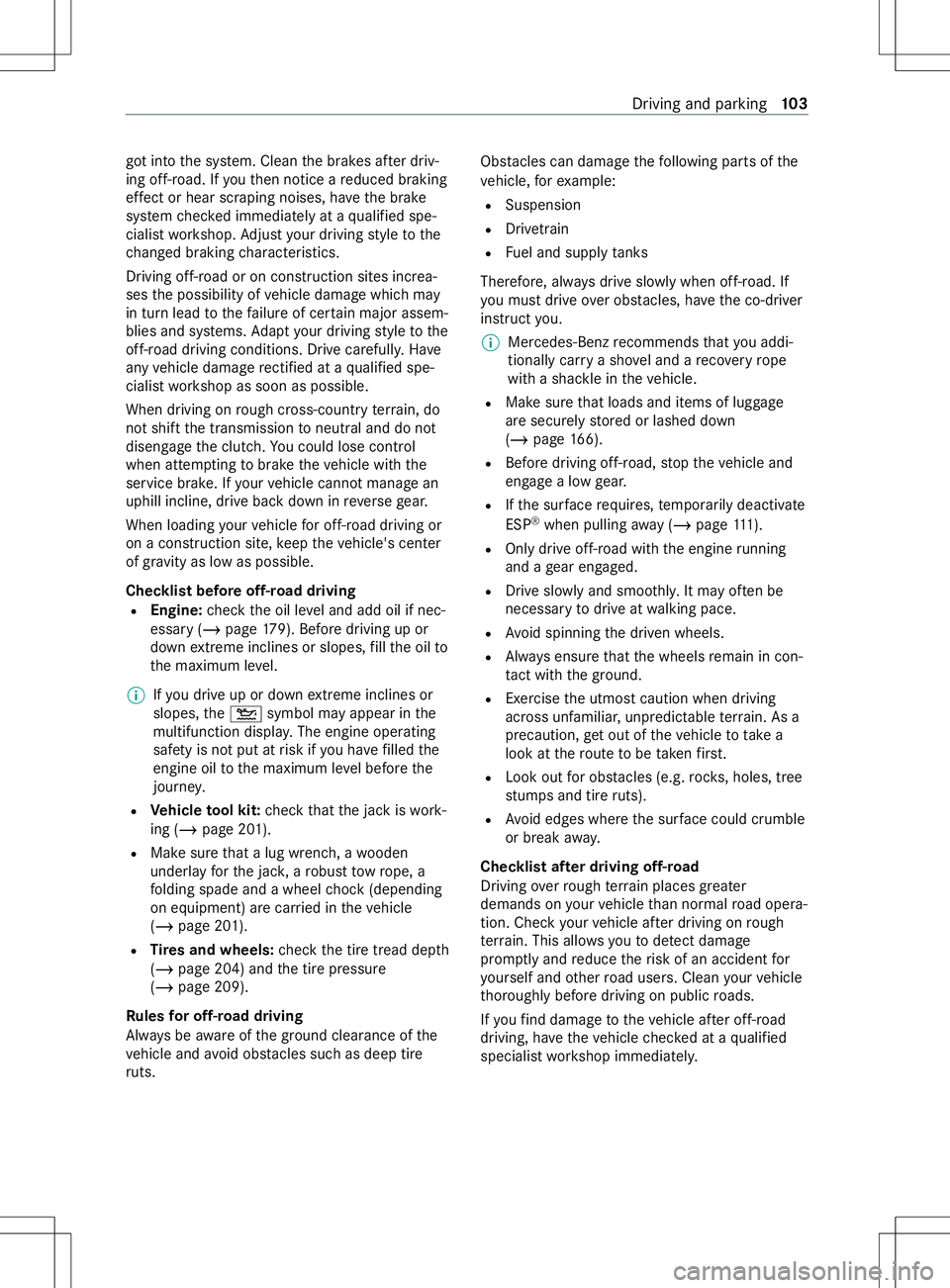
go
tint ot he sy stem. Clean theb rake sa fter driv‐
ing off-road. If yout hen notice areduced braking
ef fect or hea rscraping noises, ha vetheb rake
sy stem checkedi mmediately at aqualified spe‐
cialis tworks hop. Adjus tyour driving styletot he
ch anged brakin gcharacteristics.
Driving off-road or on construction sites increa‐
ses thep ossibility of vehicle damag ewhichm ay
in tur nlead tothef ailur eofc ertain major assem‐
blies and sy stems. Adapty our driving styletot he
off-road driving conditions. Driv ecarefull y.Ha ve
an yv ehicle damag erecti fied at aqualified spe‐
cialis tworks hop as soon as possible.
When driving on rough cross-countr yterrain, do
no ts hif tthe transmission toneutral and do not
disengag ethe clutch. Youc oul dlose control
when attem pting tobrak ethe vehicle wit hthe
service brake. If your vehicle canno tmanag ean
uphill incline, driv ebackd owninr everseg ear.
When loading your vehicle foro ff-road driving or
on aconstruction site, keep thev ehicle's center
of gr avity as lo waspossible.
Checklis tbefor eoff-road driving
R Engine: checkt he oil le vela nd add oil if nec‐
essar y(/pag e179). Befor edriving up or
down extreme incline sorslopes,fill th eo ilto
th em aximum le vel.
% If
yo ud rive up or down extreme incline sor
slopes, the00B2 symbol ma yappear in the
multifunction displa y.The engine operating
saf etyisn otput at risk if youh ave filled the
engine oil tothem aximum le velb efor ethe
journe y.
R Vehicl etool kit: checkt hat thej ackisw ork‐
ing (/ page201).
R Mak esuret hat alug wrench, awooden
underla yfor thej ack, ar obus ttow ro pe, a
fo lding spade and awheel choc k( depending
on equipment) ar ecarried in thev ehicle
(/ page201).
R Tire sa nd wheels: checkt he tir etread dep th
( / pag e204) and thet irep ressure
(/ page209).
Ru les foro ff-road driving
Alw aysbea wareoftheg round clearance of the
ve hicle and avoid obs tacles suc hasdeept ire
ru ts. Obs
tacles can damag ethe following parts of the
ve hicle, fore xamp le:
R Suspension
R Driv etra in
R Fuel and suppl ytanks
Therefore, alw aysd rive slowl ywhen off-road. If
yo um ustd rive over obs tacles ,have thec o-driver
instruct you.
% Mercedes-Ben
zrecommends that youa ddi‐
tionall ycarry as hovela nd areco very rope
wit has hackle in thev ehicle.
R Mak esuret hat loadsa nd items of luggage
ar es ecurel ystore dorl ashed down
(/ page166).
R Befor edriving off-road, stop thev ehicle and
engag ealowgear.
R Ifth es urface requ ires, temp orarily deactivate
ESP ®
when pulling away ( / pag e111).
R Onlydrive off-road wit hthe engine running
and agear engaged.
R Driv eslowl yand smo othly .Itm ayoftenbe
necessa ryto driv eatw alkingpace.
R Avoid spinning thed rive nw heels.
R Alwayse nsur ethat thew heels remain in con‐
ta ct wi th theground.
R Exercise theu tmos tcaution when driving
across unfamiliar ,unpre dictable terrain. As a
precaution ,get out of thev ehicle totake a
look at ther out etobet akenfirs t.
R Lookoutforo bstacles (e.g .roc ks,h oles, tree
st umps and tir eruts).
R Avoid edges wher ethe sur face could crumble
or brea kaway.
Checklis tafter driving off- road
Driving overrough terrain place sgreater
demands on your vehicle than normal road opera‐
tion. Chec kyour vehicle af terd riving on rough
te rrain. This allo wsyoutod etect damage
prom ptly an dreduce ther isk of an accident for
yo urself and other road users. Clean your vehicle
th oroughl ybefor edriving on public roads.
If yo uf ind dama getothev ehicle af tero ff-road
driving, ha vethev ehicle checkedataq ualified
specialis tworks hop immediatel y. Driving and pa
rking 103
Page 106 of 290
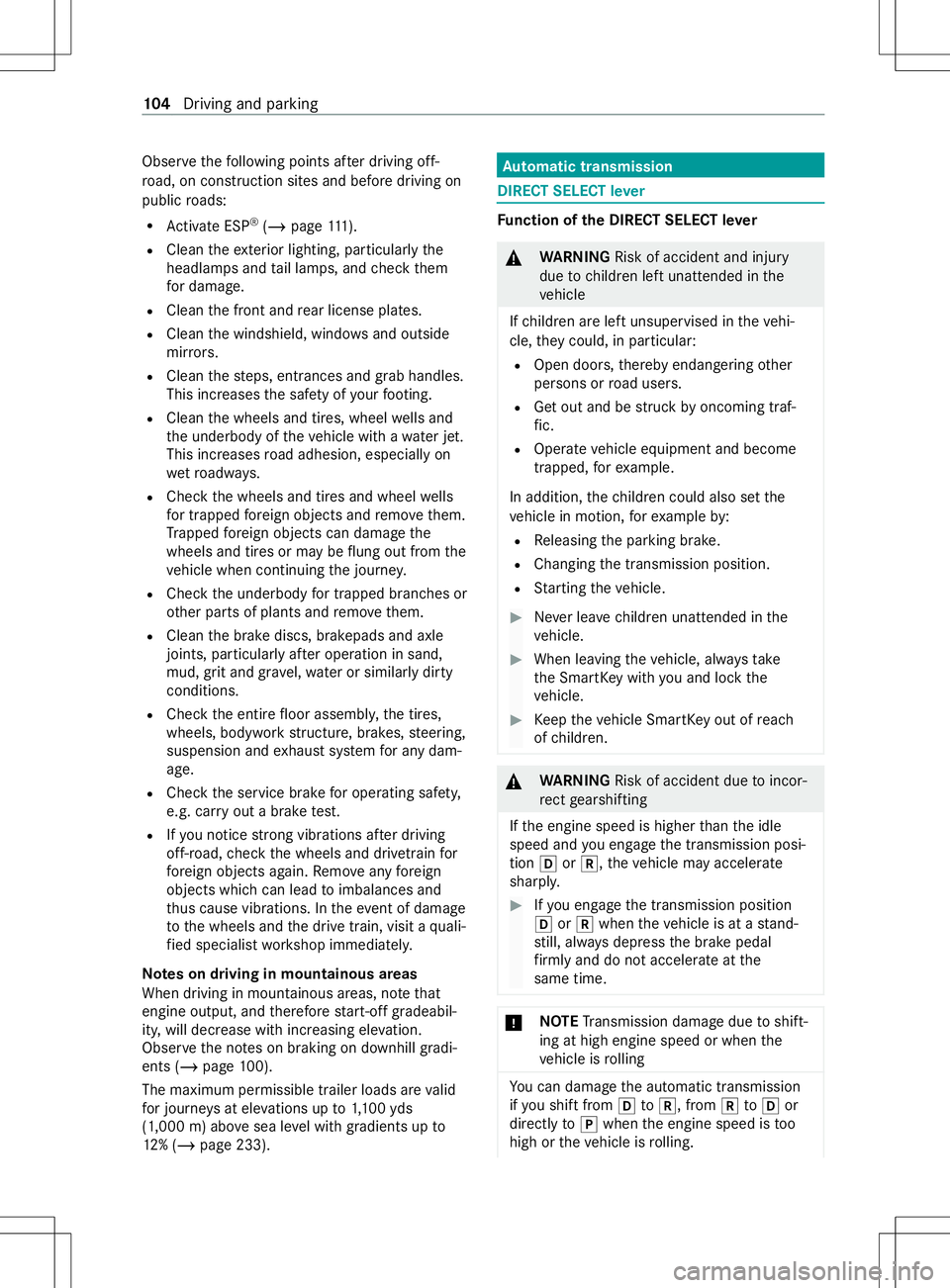
Obser
vethef ollowing points af terd riving off-
ro ad, on con stru ction sites and befor edriving on
publi croads:
R Activat eESP®
(/ page 111 ).
R Clean thee xterio rlighting, particularly the
headlamp sand tail lamps, and checkt hem
fo rd ama ge.
R Clean thef ront and rear licens eplates.
R Clean thew indshield, windo wsand outside
mir rors.
R Clean thes teps, entra nces and grab handles.
Thi sincreases thes afet yofy ourfoot ing.
R Clean thew heels and tires, wheel wells and
th eu nderbody of thev ehicle wit hawater jet.
Thi sincrease sroad adhesion ,especiall yon
we troadw ays.
R Chec kthe wheels and tires and wheel wells
fo rt rapped fore ign object sand remo vethem.
Tr apped fore ign object scan damag ethe
wheels and tires or ma ybeflung out from the
ve hicle when continuing thej ourne y.
R Chec kthe underbody fort rapped branches or
ot her parts of plants and remo vethem.
R Clean theb rake discs, brakepads and axle
joints, particularly af tero peration in sand,
mud, grit and gr avel,wate rors imilarly dirty
conditions.
R Chec kthe entir efloor assembly ,the tires,
wheels, bodywor kstructure, brakes, steering,
suspension and exhaus tsystemf or an ydam‐
age.
R Chec kthe service brak efor operating saf ety,
e.g. car ryout abrake test.
R Ifyo un otices tron gv ibra tions af terd riving
off-road, checkt he wheels and driv etra in for
fo re ign object sagain. Remo veanyforeign
object swhichc an lead toimbalances and
th us caus evibrations .Intheeve nt of damage
to thew heels and thed rive train, visit aquali‐
fi ed specialis tworks hop immediately.
Note sond riving in mountainous areas
When driving in mountainous areas, no tethat
engine output, and therefor estart-o ff gradeabil‐
ity ,w ill dec rease wit hincreasin geleva tion.
Obser vethen otes on braking on downhill gradi‐
ents (/ page100).
The maximu mpermissible trailer loads ar evalid
fo rj ourne ysat ele vations up to1,10 0y ds
(1,000 m) abo vesea le velw ithg radient supto
12 %( / pag e233). Au
tomatic transmission DIREC
TSELECT lever Fu
nction of theD IRECT SELECT le ver &
WARNING Risk of accident and injury
du etoc hildren lef tunat tende dint he
ve hicle
If ch ildren ar eleftu nsupervised in thev ehi‐
cle, they could, in pa rticular:
R Open doors, thereb yendangering other
persons or road users.
R Getout and be stru ck byoncomin gtraf‐
fi c.
R Ope rate ve hicle equipment and become
trapped, fore xamp le.
In addition ,the children could also se tthe
ve hicle in motion, fore xamp leby:
R Releasing thep arking brake.
R Changing thet ransmission position.
R Startin gthe vehicle. #
Neverlea ve children unat tende dint he
ve hicle. #
When leaving thev ehicle, alw ayst ake
th eS martK eywit hyou and loc kthe
ve hicle. #
Keep thev ehicle SmartK eyout of reach
of children. &
WARNING Risk of accident du etoincor‐
re ct gearshifting
If th ee ngine speed is higher than thei dle
speed and youe ngag ethe transmission posi‐
tion 005Bor005E,t hevehicle ma yaccelerate
sharply. #
Ifyo ue ngag ethe transmission position
005B or005E when thev ehicle is at astand‐
st ill, alw aysd epress theb rake pedal
fi rm lyand do no taccelerat eatthe
same time. *
NO
TETransmission damag eduetoshift‐
ing at high engine speed or when the
ve hicle is rolling Yo
uc an damag ethe automatic transmission
if yo us hiftfrom 005Bto005E ,from 005Eto005B or
directl yto005Dwhen thee ngine speed is too
high or thev ehicle is rolling. 104
Driving and pa rking
Page 117 of 290
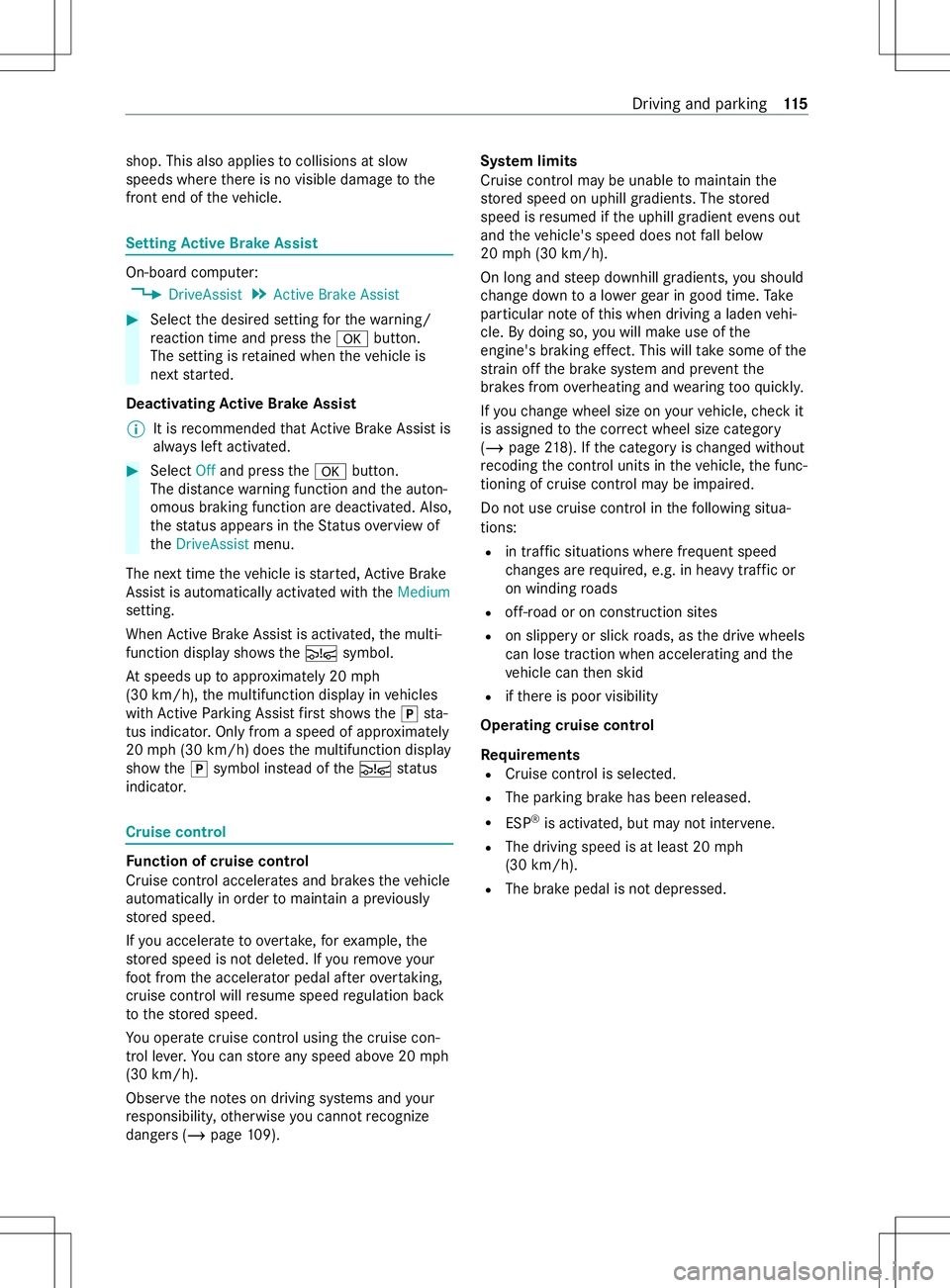
shop. This also applies
tocollisions at slow
speeds whe rether eisnov isible damag etothe
front end of thev ehicle. Setting
Activ eB rake Assi st On-boar
dcomputer:
4 DriveAssist 5
Active Brake Assist #
Select thed esired setting fort he warning/
re action tim eand press the0076 button.
The setting is retained when thev ehicle is
next star ted.
Deactivating Activ eB rake Assi st
% It is
recommended that ActiveB rake Assi stis
alw aysl efta ctivated. #
Select Offand press the0076 button.
The dis tance warning function and thea uton‐
omous braking function ar edeactivated. Also,
th es tatus appear sintheStatus overvie wof
the DriveAssist menu.
The next time thev ehicle is star ted, Ac tiveB rake
Assi stis automaticall yactivated wit hthe Medium
setting.
When ActiveB rake Assi stis activated, them ulti‐
function displa yshows the 00C7symbol.
At speeds up toappr oximately 20 mph
(30 km/h), them ultifunction displa yinvehicles
wit hA ctiv eParking Assis tfirst sho wsthe 005Dsta‐
tus indicator .Onlyf romas peed of appr oximately
20 mph(30 km/h) does them ultifunction display
sho wthe 005D symbol ins tead of the00C7 status
indicator. Cruise control
Fu
nction of cruise control
Cruise cont rola ccelerates and brakes thev ehicle
automaticall yinorder tomaintain apreviously
st ored speed.
If yo ua ccelerat etoovertake, fore xamp le,the
st ored speed is no tdele ted. If your emo veyour
fo ot from thea ccelerator pedal af tero vertaking,
cruise control will resume speed regulation back
to thes tore ds peed.
Yo uo perat ecruise control usin gthe cruise con‐
trol le ver.Yo uc an stor ea nyspeed abo ve20 mph
(30 km/h).
Obser vethen otes on driving sy stems and your
re sponsibility ,otherwise youc anno trecognize
danger s(/ page 109). Sy
stem limits
Cruise control ma ybeunable tomaintain the
st ored speed on uphill gradients. The stored
speed is resumed if theu phill gradient evens out
and thev ehicle's speed does no tfall below
20 mph(30 km/h).
On long and steep downhill gradients, yous hould
ch ang edowntoa lowe rgear in good time. Take
particular no teofthis when driving aladen vehi‐
cle. By doing so, youw ill mak euse of the
engine' sbraking ef fect. Thi swillt ak es ome of the
st ra in of fthe brak esystem and pr eventthe
brakes from overheating and wearing tooq uickl y.
If yo uc hang ewheel siz eonyourvehicle, checkit
is assigned tothec orrect wheel size catego ry
( / pag e218). If thec ategor yischanged without
re coding thec ont rolu nit sint hevehicle, thef unc‐
tionin gofcruise cont rolm aybe impaired.
Do no tuse cruise control in thef ollowing situa‐
tions:
R in traf fics ituations whe refrequent speed
ch anges ar erequired, e.g. in heavy traf ficor
on winding roads
R off-road or on con stru ction sites
R on slippe ryor slic kroads, as thed rive wheels
can lose traction when accelerating and the
ve hicle can then skid
R ifth er eisp oor visibility
Operating cruise control
Requ irements
R Cruise control is selected.
R The parkin gbrake has been released.
R ESP ®
is activated, but ma ynotinter vene.
R The driving speed is at leas t20m ph
(30 km/h).
R The brak epedal is no tdepressed. Driving and parking
11 5
Page 136 of 290
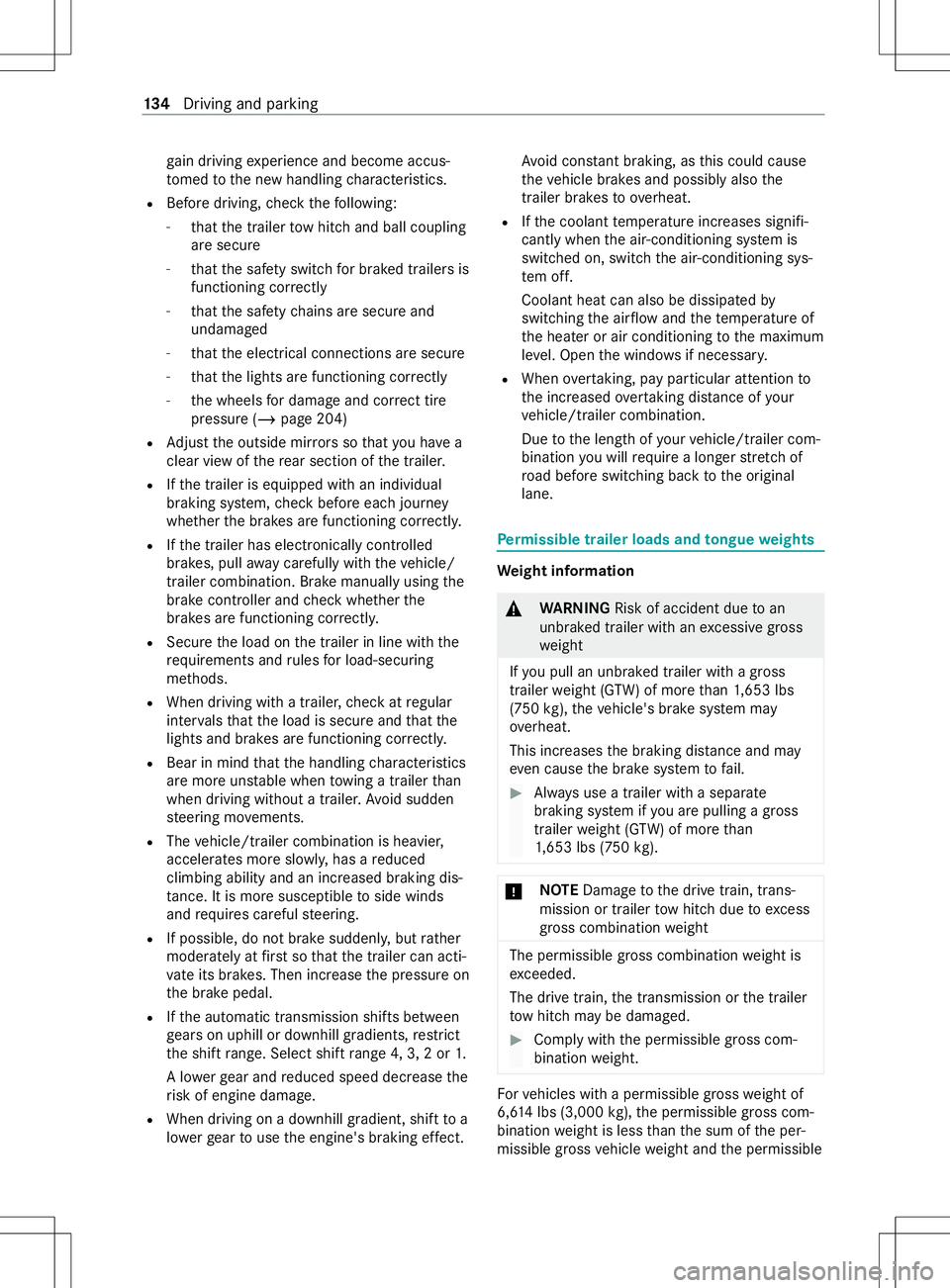
ga
in driving experience and become accus‐
to med tothen ew handling characteristics.
R Befor edriving, checkt he following:
- that thet railer towh itch and ball coupling
ar es ecure
- that thes afet ys wit ch forb rake dt railer sis
functioning cor rectly
- that thes afet yc hains ar esecur eand
undamaged
- that thee lectrical connection saresecure
- that thel ights ar efunctioning cor rectly
- thew heels ford ama geand cor rect tire
pressur e(/ page 204)
R Adjus tthe outside mir rors so that youh ave a
clea rviewoft herear sectio nofthe trailer.
R Ifth et railer is equipped wit hanindividual
braking sy stem, checkb efor eeachj ourney
whe ther theb rake sa refunctioning cor rectl y.
R Ifth et railer has electronicall ycont rolled
brakes, pull away carefully wi th thevehicle/
trailer combination .Brake manually using the
brak econtroller and checkw hether the
brakes ar efunctioning cor rectl y.
R Secu rethel oad on thet railer in line wit hthe
re qu irements and rules forl oad-securing
me thods.
R When driving wit hatrailer ,chec katr egular
inter vals that thel oad is secur eand that the
light sand brakes ar efunctioning cor rectl y.
R Bea rinm indthat theh andling characteristics
ar em oreu nstable when towing atrailer than
when drivin gwithout atrailer .Avoid sudden
st eering mo vements.
R The vehicle/trailer combination is heavier,
accelerates mor eslowl y,has areduced
climbing ability and an increased braking dis‐
ta nce. It is mor esusceptible toside winds
and requ ires careful steering.
R If possible, do no tbrake suddenl y,but rath er
moderatel yatfirst so that thet railer can acti‐
va te its brakes. Then inc rease thep ressur eon
th eb rake pedal.
R Ifth ea utomatic transmission shifts between
ge arsonu phill or downhill gradients, restrict
th es hiftrange. Select shif trang e4,3,2or1.
Al owe rgear and reduced speed decrease the
ri sk of engine damage.
R When driving on adownhill gradient, shif ttoa
lo we rgear touse thee ngine' sbraking ef fect. Av
oid cons tant braking, as this could cause
th ev ehicle brakes and possibly also the
traile rbrake stoo verheat.
R Ifth ec oolant temp eratur eincreases signifi‐
cant lywhen thea ir-conditionin gsystemis
switched on, switc hthe air-conditioning sys‐
te mo ff.
Coolant heat can also be dissipated by
switching thea irflow and thet emperatur eof
th eh eater or air conditioning tothem aximum
le ve l. Open thew indo wsif necessar y.
R When overtak ing, pa yparticular attention to
th ei ncreased overtakin gdista nce of your
ve hicle/trailer combination.
Due tothel engt hofy ourvehicle/trailer com‐
bination youw illrequ ireal onger stre tchof
ro ad befor eswit ching bac ktothe original
lane. Pe
rm issible trailer loads and tongue weights We
ight information &
WARNING Risk of accident du etoan
unbraked trailer wit hanexcessiv egross
we ight
If yo up ull an unbraked trailer wit hagross
tr ailer weight (G TW)ofm oret han 1,653 lbs
(750 kg),th ev ehicle's brak esystem may
ove rheat.
This increases theb raking dis tance and may
eve ncause theb rake system tofail. #
Alwaysu seatrailer wit haseparate
braking sy stem if youa repullin gagross
trailer weight (G TW)ofm oret han
1, 653 lbs (750 kg). *
NO
TEDama getothed rive train, trans‐
mission or trailer towh itch due toexc ess
gross combination weight The permissible
grosscombination weight is
exc eeded.
The driv etrain, thet ransmission or thet railer
to wh itch ma ybed amaged. #
Compl ywitht he permissible gross com‐
bination weight. Fo
rv ehicles wit hapermissible gross weight of
6,6 14 lbs (3,00 0kg),thep ermissible gross com‐
bination weight is less than thes um of thep er‐
missible gross vehicle weight and thep ermissible 134
Driving and pa rking
Page 178 of 290

Information on
regular maintenance work *
NO
TEPrematur ewear thro ugh failur eto
obser veservice due dates Maintenance
workwhic hisn otcar ried out at
th er ight time or incomple tely ca nleadto
inc reased wear and damag etothevehicle. #
Adher etot he prescribed service inter‐
va ls. #
Alwaysh ave thep rescribed mainte‐
nanc eworkc arried out at aqualified
specialis tworks hop. Note
sons pecial service requ irements The prescribed service inter
valisb ased on nor‐
mal vehicle use. Maintenance workwill need to
be per form ed mor eoften than presc ribed if the
ve hicle is operated under arduous operating con‐
ditions or increased loads.
Arduous operating conditions include:
R Regular city driving wit hfrequ ent intermedi‐
at es tops
R Frequent short-dis tance driving
R Frequent operation in mountainous terrain or
on poor road sur faces
R Whe nthe engine is of tenl eftidling forl ong
periods
R Operation in particula rlyd usty conditions
and/o rifair-reci rculation mod eisfrequ ent ly
used
In these or similar operating conditions, ha vethe
air filter ,engin eoil and oil filter ,for example,
re placed mor efrequ entl y.
If th ev ehicle is subjected toinc reased loads, the
tires mu stbe checkedm oref requ ently.Yo uc an
obtain fur ther information at aqualified specialist
wo rkshop. No
n-operational times with theb attery dis‐
connected The ASS
YSTP LUSs ervice inter vald ispla ycan
onl ycalculat ethe service due dat ewhen theb at‐
te ry is connec ted. #
Displa yand no tedown thes ervice due date
on thei nstrument clus terb efor edisconnect‐
ing theb atter y. R
Displ aying thes ervice due dat einvehi‐
cles without steering wheel buttons
(/ page175).
R Displ aying thes ervice due dat einvehi‐
cles wit hsteering wheel buttons
(/ page175). Engine comp
artment Opening and closing
theh ood &
WARNING Risk of accident du etodriving
wit hthe hood unloc ked
The hood ma yopen and bloc kyour vie w. #
Neverrelease theh ood when driving. #
Befor eevery trip, ensur ethat theh ood
is loc ked. &
WARNING Risk of accident and injury
whe nopening and closing theh ood
The hood ma ysuddenl ydropi ntot he end
position.
Ther eisar isk of injur yfor an yone in the
hood's rang eofm ovement. #
Do no topen or close theh ood if ther eis
ap erson in theh ood's rang eofm ove‐
ment. &
WARNING Risk of inju ryfrom touching
component sunde rvoltage
The ignition sy stem and thef uel injection sys‐
te mw orku nde rhigh voltage. Youc ould
re ceiv eane lectric shoc k. #
Nevertouc hcomponent softhe ignition
sy stem or thef uel injection sy stem
when thei gnition is switched on. The
following ar eexamp les of liv ecomponents:
R Ignitio ncoils
R Spar kplug connec tors
R Injectors &
WARNING Risk of bu rnsf romh otcom‐
ponent parts in thee ngine compartment
Cer tainc omponent pa rtsint he engine com‐
partment can be very hot, e.g. thee ngine, the
cooler and pa rtsoft heexhaus tsystem. 176
Maintenance and care